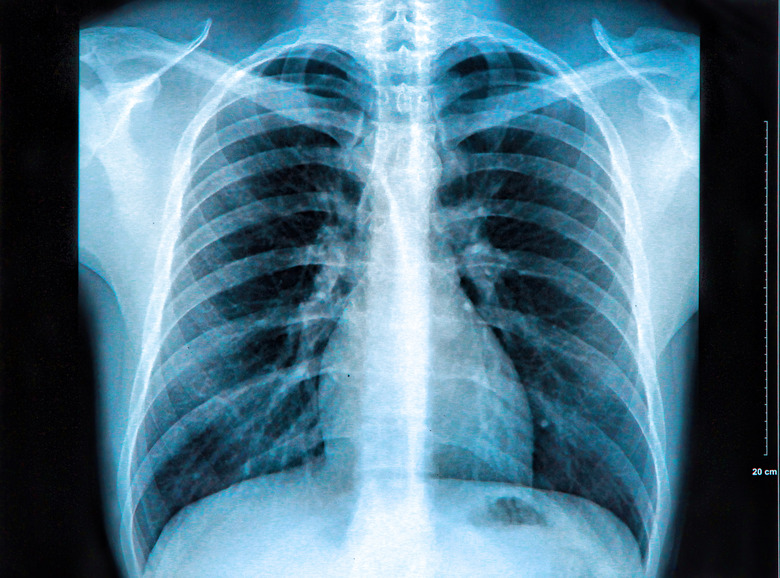How Does The Skeletal System Work With The Respiratory System?
The human skeletal system includes bones, joints and cartilage associated with the skeleton. The skeletal system has a number of functions. It provides support and structure for the body and attachment points for muscles, ligaments and other connective tissue. It also protects organs; the skull protects the brain, the ribs protect the heart and lungs, and the spinal vertebrae protect the spinal cord.
The human respiratory system is responsible for bringing oxygen into the body for cellular metabolism and for removing carbon dioxide that is a waste product of that metabolism. The respiratory system includes the organs responsible for breathing: the nose, trachea, throat and lungs.
At first glance, the skeletal system seems to have little to do with the respiratory system. In fact, the two systems are intricately connected and work together to keep everything working the way it should.
TL;DR (Too Long; Didn't Read)
The skeletal system is responsible for supporting the body and helping it to move, as well as providing attachment points for muscles and ligaments and protection for certain organs such as the brain. The human respiratory system includes the organs that are used for breathing, such as the nose, throat and lungs. The two systems are intricately connected and work together to keep everything functioning properly in the body.
Bones in the Nose
Air first enters the body for respiration through the nose or the mouth. Except for people with nasal obstructions, such as congestion or a deviated septum, and people engaging in heavy breathing for reasons such as exertion, the body tends to prefer the airway through the nose for respiration. When air enters through the nose, hairs that line the inside of the nose, called cilia, work with the mucus lining to trap particulates and other foreign bodies and prevent them from entering the lungs. They also help to warm and moisten the air, because cold, dry air irritates the lungs.
As the air travels up the nasal passageway and toward the nasopharynx – the area where the nasal passage meets the back of the throat – it is swirled around by three sets of paired bones. These bones are collectively called the nasal conchae. They form swirled shapes like shells, which helps to warm the air even more before it reaches the throat and continues to the lungs.
Red Blood Cells
The center of many human bones consists of bone marrow. Most bone marrow is red or yellow. Red marrow is responsible for the creation of both red and white blood cells and platelets, which are the major components in blood.
Red blood cells are tiny, flat discs that contain hemoglobin, a molecule that can carry oxygen. As part of the circulatory system, red blood cells travel to capillaries in the lungs where they pick up oxygen that the lungs inhaled and then bring the oxygen to all parts of the body via the blood vessels. The body's cells use oxygen for metabolism, and this process creates the waste product carbon dioxide. When the red blood cells deposit the oxygen at its destination, they pick up carbon dioxide and bring it back to the lungs, where it is exhaled. With the help of the lymphatic and circulatory systems, the skeletal system works with the respiratory system by creating red blood cells in the bones that aid in respiration facilitated by the lungs.
The Thoracic Cage
The thoracic cage (or rib cage) is fundamental to the healthy functioning of the respiratory system. It consists of the 12 pairs of ribs, the 12 thoracic vertebrae in the spine and the sternum, which is often called the breastbone. With exceptions, ribs are connected in the front to the vertical sternum and in the back to the spinal vertebrae.
When the body inhales, the ribs move upward and outward, expanding the space within them where the lungs are, which allows the lungs to expand with air. Muscles attached to the sternum and thoracic cage aid in respiration. In particular, the intercostal muscles, which are attached to the ribs, help with thoracic stability during respiration. The most important muscle for respiration is the diaphragm, which is attached to the thoracic cage in several locations and which lowers to allow the ribs to expand and air to enter the lungs before returning to its original position upon exhale.
Cite This Article
MLA
E., Rebecca. "How Does The Skeletal System Work With The Respiratory System?" sciencing.com, https://www.sciencing.com/skeletal-system-work-respiratory-system-6888059/. 7 May 2018.
APA
E., Rebecca. (2018, May 7). How Does The Skeletal System Work With The Respiratory System?. sciencing.com. Retrieved from https://www.sciencing.com/skeletal-system-work-respiratory-system-6888059/
Chicago
E., Rebecca. How Does The Skeletal System Work With The Respiratory System? last modified March 24, 2022. https://www.sciencing.com/skeletal-system-work-respiratory-system-6888059/
